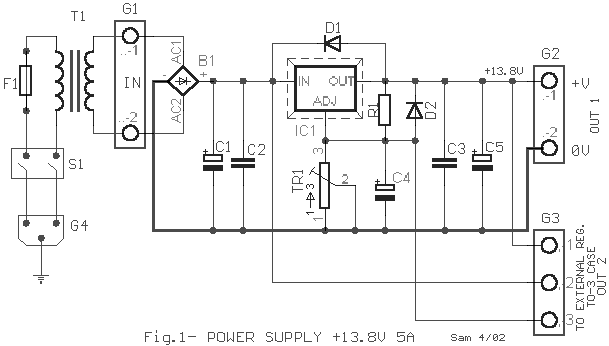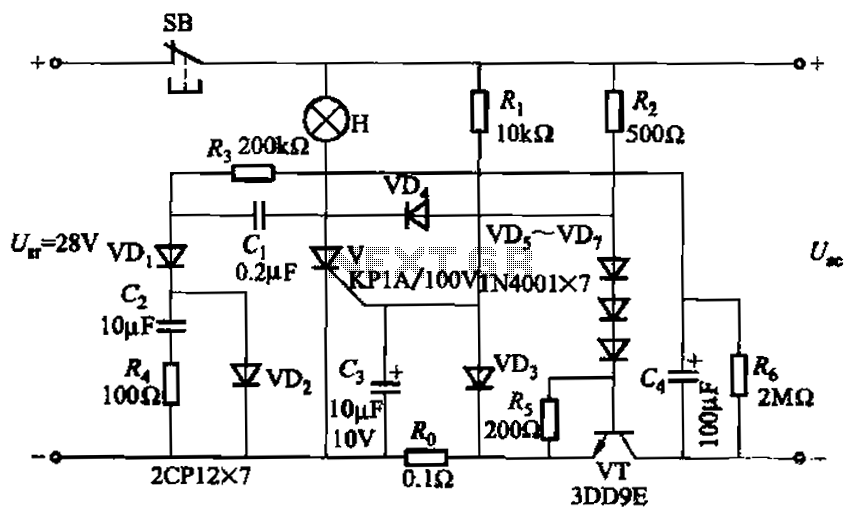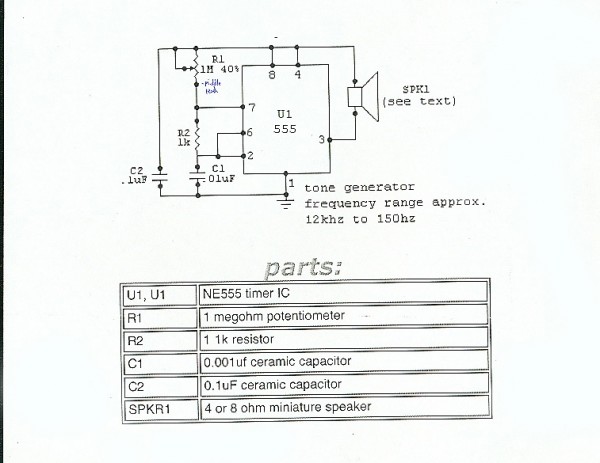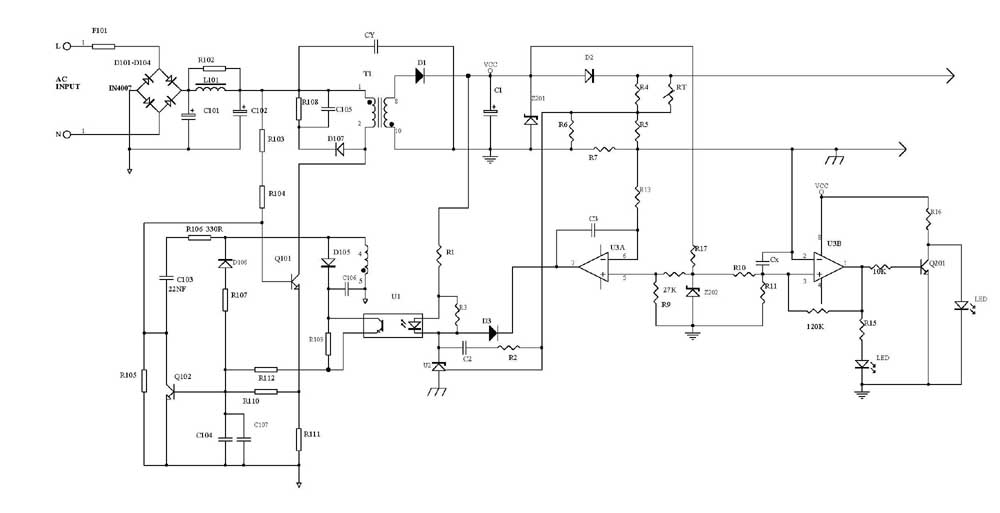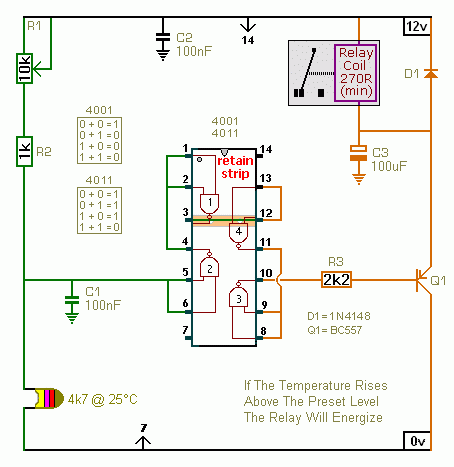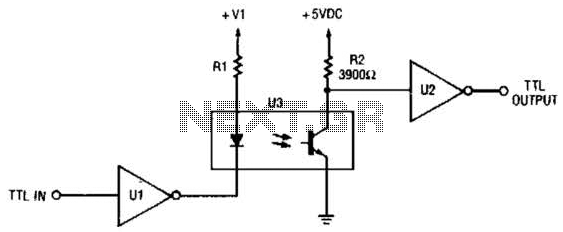
Cool small Circuits
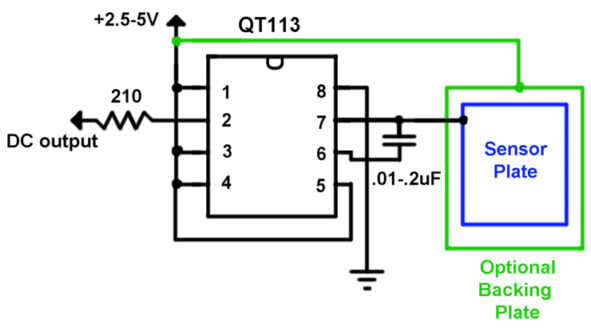
The QT113 is a capacitance touch sensor that does not require AC line voltage to operate. Instead, it detects changes in capacitance caused by the proximity of a user’s body. A sensor plate measuring 2 inches square can sense a finger from several inches away, even through materials such as plastic, glass, or brick. The detection range increases with the size of the metal sensor plate, which can vary from a thin wire to a large metal door screen. The circuit configuration allows for proximity detection, where the output signal goes low when a finger is near or in contact with the plate. To toggle the output, the user can touch the plate once to turn it on and again to turn it off, connecting pins 3 and 4 to ground. The direct current output can drive an LED or interface with a microcontroller. Increasing the capacitor value enhances the detection distance. For focused detection at the front of the sensor plate, a backing plate can be added, with a double-sided copper printed circuit board of thickness 1/32" to 1/16" being suitable.
Additionally, an audio amplifier circuit is described, capable of amplifying various audio inputs. This amplifier can boost the output from a Picaxe or other microcontroller to produce beeps, sound effects, or melodies, achieving a maximum gain of 20. A motor controller is also included, designed to control two motors for forward and reverse operation with speed control, making it ideal for small robotic applications. By setting pins A-D high or low in different combinations, the user can determine the motor direction. Speed control is achieved by sending pulse width modulation signals to two of the pins, with each motor capable of operating at up to 600 mA and 36 volts. Ground pins 4, 5, 12, and 13 serve as heat sinks for the integrated circuit (IC), and when operating near maximum ratings, these should be connected to an external heat sink. Additionally, a power supply circuit that operates from a 12-volt car battery is mentioned, capable of delivering up to 1.5 amps of power. If the current exceeds 1 amp, it is advisable to attach a heat sink to the LM317. In certain applications, such as motor power or basic circuits like blinking LEDs, capacitors may be omitted. A servo controller is also available for testing servos, with a caution that excessive adjustment of the potentiometer in either direction may strain and damage some servos.The QT113 is a capacitance touch sensor. Unlike many touch sensors, it does not rely on AC line voltage to be present in the room. Instead, it detects the change in capacitance the closeness of your body produces. A 2" square sensor plate can detect the closeness of your finger from several inches away. It will detect a finger even through plastic , glass or brick. The larger the metal sensor plate, the more the distance it will detect. The sensor plate can be as thin as a wire or as large as a metal door screen. Using the circuit above will detect proximity with the output going low when your finger is close or touching. To toggle the output, turning it on when you touch the plate once, and then turning it off when you touch it again-tie pin 3 and 4 to ground.
The DC output will directly drive an LED or can go to an input of a microcontroller. Up to a point, the larger the value of the capacitor, the larger the detection distance. If you want to detect only at the front of a sensor plate, you can add a backing plate. 1/32" to 1/16" double-sided copper printed circuit board makes a good front and back plate. Here is a simple audio amplifier that will amplify various audio inputs. This amp will amplify an output pin from a Picaxe or other microcontroller to provide beeps, sound effects, or tunes. In this configuration, it has the maximum gain of 20. This motor controller can control two motors forward and reverse with speed control. They can be controlled together or independently. It is ideal for smaller Robots. By putting pins A-D high or low in different combinations, forward or reverse is effected. Sending a pulse width modulated signal to two of the pins creates the speed control. Each motor can run at up to 600ma and 36 Volts. Pins 4, 5, 12, and 13 are the ground pins which provide the heat sink for the IC. If you run this controller near the maximum ratings, you should solder these pins to some kind of external heat sink.
This makes a good power supply that will run off a 12 volt car battery. It will provide up to 1. 5 amps of power. If you use it at 1 amp or more, you should heat sink the LM317. For some circuits, like motor power or simple circuits like blinkys, the capacitors can be eliminated. This servo controller is handy for testing servos. Use some care, as turning the potentiometer too far in either direction can strain and damage some servos.
🔗 External reference
Additionally, an audio amplifier circuit is described, capable of amplifying various audio inputs. This amplifier can boost the output from a Picaxe or other microcontroller to produce beeps, sound effects, or melodies, achieving a maximum gain of 20. A motor controller is also included, designed to control two motors for forward and reverse operation with speed control, making it ideal for small robotic applications. By setting pins A-D high or low in different combinations, the user can determine the motor direction. Speed control is achieved by sending pulse width modulation signals to two of the pins, with each motor capable of operating at up to 600 mA and 36 volts. Ground pins 4, 5, 12, and 13 serve as heat sinks for the integrated circuit (IC), and when operating near maximum ratings, these should be connected to an external heat sink. Additionally, a power supply circuit that operates from a 12-volt car battery is mentioned, capable of delivering up to 1.5 amps of power. If the current exceeds 1 amp, it is advisable to attach a heat sink to the LM317. In certain applications, such as motor power or basic circuits like blinking LEDs, capacitors may be omitted. A servo controller is also available for testing servos, with a caution that excessive adjustment of the potentiometer in either direction may strain and damage some servos.The QT113 is a capacitance touch sensor. Unlike many touch sensors, it does not rely on AC line voltage to be present in the room. Instead, it detects the change in capacitance the closeness of your body produces. A 2" square sensor plate can detect the closeness of your finger from several inches away. It will detect a finger even through plastic , glass or brick. The larger the metal sensor plate, the more the distance it will detect. The sensor plate can be as thin as a wire or as large as a metal door screen. Using the circuit above will detect proximity with the output going low when your finger is close or touching. To toggle the output, turning it on when you touch the plate once, and then turning it off when you touch it again-tie pin 3 and 4 to ground.
The DC output will directly drive an LED or can go to an input of a microcontroller. Up to a point, the larger the value of the capacitor, the larger the detection distance. If you want to detect only at the front of a sensor plate, you can add a backing plate. 1/32" to 1/16" double-sided copper printed circuit board makes a good front and back plate. Here is a simple audio amplifier that will amplify various audio inputs. This amp will amplify an output pin from a Picaxe or other microcontroller to provide beeps, sound effects, or tunes. In this configuration, it has the maximum gain of 20. This motor controller can control two motors forward and reverse with speed control. They can be controlled together or independently. It is ideal for smaller Robots. By putting pins A-D high or low in different combinations, forward or reverse is effected. Sending a pulse width modulated signal to two of the pins creates the speed control. Each motor can run at up to 600ma and 36 Volts. Pins 4, 5, 12, and 13 are the ground pins which provide the heat sink for the IC. If you run this controller near the maximum ratings, you should solder these pins to some kind of external heat sink.
This makes a good power supply that will run off a 12 volt car battery. It will provide up to 1. 5 amps of power. If you use it at 1 amp or more, you should heat sink the LM317. For some circuits, like motor power or simple circuits like blinkys, the capacitors can be eliminated. This servo controller is handy for testing servos. Use some care, as turning the potentiometer too far in either direction can strain and damage some servos.
🔗 External reference
